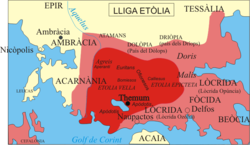League of the Aetolians Koinon tōn Aitōlōn | |||||||||
|---|---|---|---|---|---|---|---|---|---|
| 4th century BC–188 BC | |||||||||
 | |||||||||
| Capital | Thermon (meeting place) | ||||||||
| Common languages | Doric Greek, Koine Greek | ||||||||
| Religion | Ancient Greek religion | ||||||||
| Government | Confederation of tribal communities and cities | ||||||||
| Strategos | |||||||||
| Legislature | Aetolian assembly | ||||||||
| Historical era | Classical Antiquity | ||||||||
• Established | 4th century BC | ||||||||
• Treaty with Rome after the Roman–Seleucid War | 188 BC | ||||||||
| |||||||||
| Today part of | Greece | ||||||||
The Aetolian (or Aitolian) League (Greek: Κοινὸν τῶν Αἰτωλῶν)[1] was a confederation of tribal communities and cities[2] in ancient Greece centered in Aetolia in Central Greece. It was probably established during the early Hellenistic era, in opposition to Macedon and the Achaean League. Two annual meetings were held at Thermon and Panaetolika. The league occupied Delphi from 290 BC and steadily gained territory until, by the end of the 3rd century BC, it controlled the whole of central Greece with the exception of Attica and Boeotia. At its peak, the league's territory included Locris, Malis, Dolopes, parts of Thessaly, Phocis, and Acarnania. In the latter part of its power, certain Greek city-states joined the Aetolian League such as the Arcadian cities of Mantineia, Tegea, Phigalia and Kydonia on Crete.[3]
During the classical period the Aetolians were not highly regarded by other Greeks, who considered them to be semi-barbaric and reckless.[4] Their League had a complex political and administrative structure, and their armies were easily a match for the other Greek powers. However, during the Hellenistic period, they emerged as a dominant state in central Greece and expanded by the voluntary annexation of several Greek city-states to the League. Still, the Aetolian League had to fight against Macedonia and were driven to an alliance with Rome, which resulted in the final conquest of Greece by the Romans.
- ^ "Αἰτωλός - Ancient Greek (LSJ) 👍". lsj.gr. Retrieved 2020-07-28.
- ^ Grainger, 1999
- ^ Hogan, 2008
- ^ West, 1902